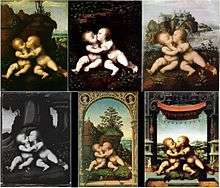The Holy Infants Embracing
_-_The_Holy_Infants.jpg)
The Holy Infants Embracing is a painting ascribed to Leonardo da Vinci, housed in the Capodimonte Gallery in Naples, southern Italy. It is thought to represent the infant Christ embracing his cousin John the Baptist. The subject matter relates to the two paintings of the Virgin of the Rocks by Leonardo and numerous other Renaissance works by Raphael and others of the meeting of the two children on the road to Egypt while escaping the Massacre of the Innocents.
History
It was viewed in 1854 and described as "a very fine work", but very dark. In 1807 it was sold as a Leonardo da Vinci and fetched 280 guineas. William Beckford sold it and Alexander Baring (Baron Ashburton) bought it from an intermediary shortly afterwards.
In 1968 the painting was bought at auction in London for less than $2,000. A 2007 special titled "Da Vinci's Lost Code" on the Discovery Channel, featuring an interview with Dutch art dealer who bought it, stated the figure was $1500. By late 1979 it had been viewed by a number of experts and a comparison made with the Virgin of the Rocks in the National Gallery, London, painted by Leonardo to fulfill a commission to the Confraternity of the Immaculate Conception, and probably also worked on by other hands, in particular the de Predis brothers with whom the commission was shared. Another version of the work exists in the Royal Collection and is ascribed to Leonardo's pupil Marco d'Oggiono.
According to Stephen Holmes, who has written a book The Lost Leonardo (publication, 2007), the consensus among the experts was that it was from the same hand as the Virgin of the Rocks in London, and equal in quality. Holmes points out the fine handling of the details, in particular the expertly painted anemones in the foreground of the painting which strongly resemble those in the Virgin of the Rocks. The painting has been the subject of an English language TV documentary ("Da Vinci's Lost Code" - Discovery Channel 14 May 2006) which examined the possibility that a number of versions of "The Holy Infants" painting were produced by various artists. Moreover, it hypothesized that, whilst some were interpretations painted by various artists over the years, some may actually have been from the "da Vinci house" (i.e., painted by da Vinci's pupils), which may or may not have been contributed to by Leonardo himself.
Other versions

The subject of two Infants kissing was an inspirational source of quite a few (about thirty) copies of pupils and followers of Leonardo da Vinci. An early sketch of the subject by da Vinci himself is held at Windsor collection. The sheet shows various studies of Madonna and Baby playing with the cat, while at the very bottom we see two infants kissing and embracing each other. The sketch is quite different from the version presented at numerous compositions, while the baby on the right is shown in a very same pose as Jesus in Virgin of the Rocks. The connection between those paintings is evident in two copies made by Marco d'Oggiono (one of them - the Thuelin Madonna)and copy made by Bernardino dei Conti (lost during World War II). Madonna, very much like as the one depicted in Virgin of the Rocks is seen blessing two kissing children, representing Jesus and St John the Baptist. Other copies show half-length figure of Madonna leaning other the table with figures of embracing children (like copy by school of Leonardo da Vinci held at Burchill Collection, Milan, and a copy ascribed either to Marco d'Oggiono or Giampietrino). The painting of Holy Family (including holy infants embracing) by Bernardino Luini held at Prado, Madrid shows a similar representation. Most of the copies show only the group of two children in a quite different background. These include copies by Marco d'Oggiono, depicting holy children in a background of castle (Milan), grotto, rocky landscape (Windsor collection). The subject of two children kissing was repeated quite a lot of times by another follower of Leonardo - Joos van Cleve. He often produced almost identical paintings of the subject: like three paintings held respectively at Museo Musei vicino Matteo Lampertico Arte antica e moderna, Milan; private collection, Switzerland and private collection in USA (showing a very similar background to the Windsor version; also in Royal collection, Brussels, The Art Institute of Chicago and Mauritshuis collection, Hague. Other copies by artist are held also at Naples and Vienna, sold at various auction houses recently. Joos van Cleve is responsible for introducing the composition among artists of Northern Europe, while numerous copies today are ascribed to the followers of Joos van Cleve.